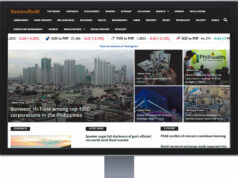AUB gears up for China market: A Q&A
By Carmina Angelica V. Olano
SINCE its establishment in 1997, the Asia United Bank (AUB) has continuously transformed its processes digitally to become, in the words of AUB Vice-President and Credit Cards Business Head Maria Magdalena V. Surtida, a “bank capable of superior innovation.” For instance, AUB fully automated its remittances in 2000, pioneered the straight-through processing of remittances in 2006, and introduced the first virtual teller kiosk in 2009 to speed up its branch transactions.
It didn’t stop there. In November 2017, the bank launched AUB PayMate, a mobile application allowing merchants to accept payments by using a smartphone and an Internet connection. This is faster and more far-reaching than installing point-of-sale (POS) terminals, a space already dominated by large banks.
In its latest forays, the bank has partnered with mobile payment giant WeChat Pay to enable duly acquired local merchants to accept payments from Chinese tourists.
Through introducing this mobile payments-accepting facility, the bank aims to level the playing field for all kinds of entrepreneurs, including the informal ones.
With these in mind, BusinessWorld sought out AUB’s Ms. Surtida for her thoughts on the future of its mobile payment facilities in the Philippines and how the bank looks to benefit from it. Below are excerpts of the interview.
What made the bank decide to partner with WeChat Pay? Was this decision made with the Chinese market in mind? Or are there other considerations?
First, we recognized the Chinese tourists as an attractive target market because of its size and potential. Last year, Chinese tourists had the second most arrivals in the country at 968,447, next to Koreans and overtaking the US.
They (Chinese tourists) have been growing by double-digit-growths in the past years with 43.33% last year. If they continue to exhibit the same growth, then we could see them to be our top visitors. The Department of Tourism expects Chinese visitors to reach 1.5 million this year.
Second, we also considered our intent in venturing to electronic wallet (e-wallet) mobile payments. What a better way to earn from e-wallet mobile payments than by partnering with mobile payment giant WeChat Pay?
Third, we wanted to add to our existing suite of banking products. More products will attract new customers, as well as engage and deepen new and existing customer relationships.
What customer needs did these products meet specifically?
For these products, there are two kinds of customers: the Chinese tourists who would use WeChat for payments and the merchants who will accept these payments.
Chinese tourists can now use their WeChat application to pay in-store and online purchases. It is fast, convenient and seamless way of paying that is more secure than carrying cash. It is hassle-free because they don’t need to exchange their RMBs (Yuan Renminbis) to PHP (Philippine peso).
For merchants, WeChat Pay has a lot of values: they instantly build connections with Chinese tourists; they generate more revenues as they will attract more Chinese tourists; they gain access to Chinese mainlanders through their electronic commerce sites, like hotels and airlines; and level the playing field for small and large enterprises (like a high-end resort and a tricycle driver).
WeChat Pay is a Chinese native brand. If the Chinese tourists see these options, they would prefer to use them over cash.
How will these partnerships serve to differentiate AUB from other banks or financial institutions who have bigger market shares or who are engaged in similar arrangements?
What placed AUB at an advantage is our very lean and digital structure. Because of the bank’s size and structure, we are able to react to market opportunities faster and able to adapt technology faster. WeChat Pay was offered to us in January last year. We have been developing our platform since March after that. We became live with the mobile payment in November. So, if you have digital as a default capability [and you] add this mobile payment giant, it blends really well.
In terms of merchant acquiring, this partnership allows us to differentiate ourselves better. WeChat Pay is one of our “foot-in-the-door” products, but we are not looking at it as just that. It’s a long-term investment for the entire bank. Once entrepreneurs become our merchants, they would need to open an account with us. This opens up a lot of opportunities because now we can cross sell our other existing products, like housing, credit card, personal, salary, corporate credit card, and other SME (small and medium enterprises) loans.
We may not have a retail synergy, like banks with department stores and the like, but we have a lot of local Chinese depositors who are entrepreneurs who operate retail establishments today. So, our default is to go to them and introduce the opportunities WeChat Pay brings.
Could you describe the traction for the payment facility in terms of merchant adoption? How many merchants have so far used WeChat Pay?
We get a lot of traction from merchants that are servicing and would like to attract Chinese tourists. We have observed that payments through these facilities are made in three major categories: 40% or majority in shopping outlets, about 25% in dining merchants, 21% in resorts and hotels, and the rest being a mix of traveling experiences, novelty items, etc.
Today, we are close to 2,000 retail outlets. This is still a small number compared to about a million entrepreneurs in the Philippines, and about a few hundreds of thousand merchants accepting Visa or Mastercard. So, we are targeting both — those with POS terminals already and the nontraditional merchants, such as any tricycle driver, an English teacher or someone selling online.
Do customers/merchants pay a fee per transaction? How does AUB earn from this arrangement?
Chinese tourists have no extra costs when using WeChat Pay. Meanwhile, merchants are charged a fee for every transaction. But unlike with POS terminals, we do not require a minimum volume and higher product rates from merchants. No transaction, no revenue, no charge.
How long does it take for merchants to be accredited in using WeChat Pay?
If they can complete the requirements today, we can onboard them after 1-2 days. Some merchants were able to do it within the day. They just need to follow these steps: complete merchant accreditation documents; open an AUB account; have a smartphone; connect to the Internet; and download the AUB PayMate app to process transactions.
Specifically, how does the bank measure the success of these products? What are the targets that the bank looks to achieve in using them in the short- and long-term?
Success of the project is measured by the number of outlets that we open. This is similar to how WeChat measure its performance in China. For the bank, it is the number of accounts opened. Later on, we will measure what we have done with these accounts to deepen our relationships. Have we offered enough banking products to help our merchants?
Revenue will follow if you have a lot of outlets. By end-April, we hope to register 3,000 outlets. For the whole year, our target is 10,000 outlets. This would be a good target already, considering these are new products for local merchants. A lot of training and introducing needs to be done.
What or who are driving growth in the adoption of WeChat Pay so far?
Our branch network plays a major role. Our branch goes around offering these to our retail customers. Our digital efforts are also helping us. Currently, our ads in YouTube, Google, and Facebook generate traffic to our website for inquiries. We also have telesales efforts writing to corporations and small and medium enterprises. Our PR partners as well who help us promote the idea. The management… who has a very strong support to this initiative. So, from top management down to our branches, this is something that is top of mind.
Aside from one-on-one presentations, we also conduct caravans where we invite merchants in key locations in the Philippines. In Boracay and Chinatown Manila, more than a hundred merchants have attended. Other places we have visited were Puerto Princesa and El Nido (in Palawan); Tagbilaran and Panglao (in Bohol) … Cebu and Lucena (Quezon). We are set to conduct our orientations in Mindoro, Davao, and Manila Bay area.
In light of incidents with regard to security breaches, what measures or safeguards did the bank implement when using the app for payments?
For Chinese tourists, all payments are “push” transactions — the user does everything. Nothing happens unless the customers approve the transaction. To pay, the customer encodes his/her pin, and scan the item or merchant’s QR (Quick Response) code.
For merchants, the AUB PayMate requires a designated username and password for the owner and/or the cashier. The business owner can limit the access rights of his/her employees. For example, the cashier can only view his/her daily transaction logs, the accountant can view transaction reports. Business owners can view transaction reports and are notified of successful transactions in real time.
How much does the bank expect their WeChat Pay payments volume to grow this year? What about in the next three to five years?
Since we have started acquiring merchants in January this year, we hope to record a very big volume of transactions. We have seen transactions coming in, and they have very good potential. It’s promising.
In the next three to five years, transactions will be driven by the Philippine-China relationship. More tourists mean more transactions.
What other developments can we expect from AUB from today onwards? Do you have plans to allow local users of WeChat?
This year, we will be introducing our own wallet for our local app users. For now, we can call it “AUB Pay.” We need to, because we have a bank customer base that we would like to leverage on. By doing so, they can also use their mobile phones when paying our existing merchants. For merchants, AUB Pay will be incorporated in their same AUB PayMate. The only difference is there will be another option along with WeChat. Give us a few months (and) we’ll launch within the year. It’s in the works already.
We are also excited to put more products with our AUB PayMate like other e-wallets, other fintechs. There is a lot of potential because our technology is ready.
Being one of the first banks or financial institutions in the country that have introduced cashless payments via social media app, what can you say about the industry’s direction?
We will see other banks or financial institutions doing the same thing. After all, the Philippines has one of the highest mobile penetration, yet we still have one of the lowest record of mobile transactions. Also, our demographics show a lot of our young people are also tech savvy. This is a good combination. These will be a big consideration for banks and other fintechs to introduce e-wallets and mobile payments.
I think we are in a good position, when the tipping point for mobile payments in the Philippines comes. We are confident, we enjoy the ride and we want to learn more. We want to be there when it happens.



